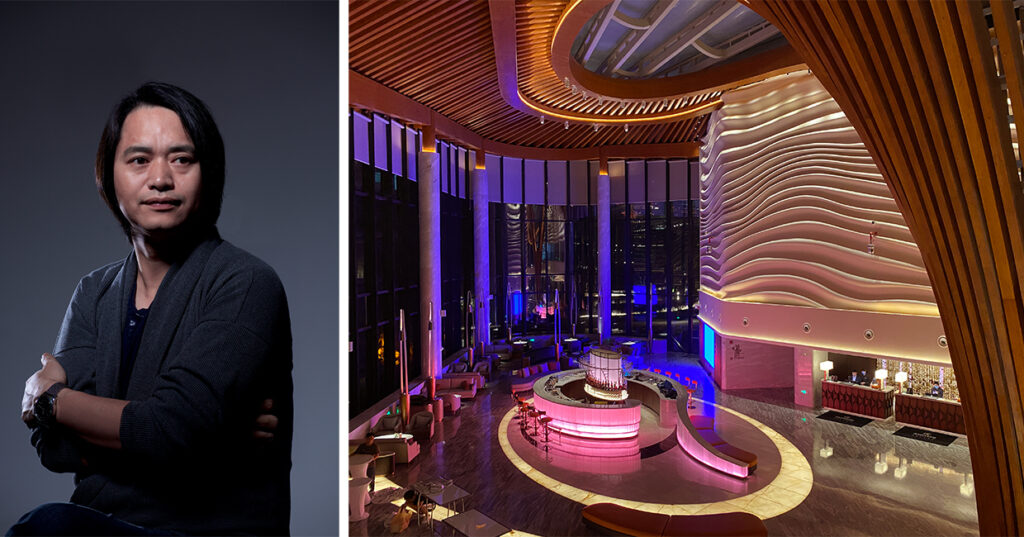As a lighting designer who has been part of the lighting industry for 30 years, Carry Yu’s experience of lighting design covers five-star hotels to hot spring resorts, from the snowy north to the southern coast, where he has contributed significant lighting design works to the world. As general manager and design director of CSLC International Lighting Consultant Co (located in China), Carry’s design philosophy is to give light an organic form, and realise the ideal of a space with our heart, carrying the story of people’s lives. Through his creativity and wisdom, Carry hopes to add warmth and intrigue to the spaces for which he designs lighting.
Unlike many other lighting designers, Carry Yu started his career in the lighting manufacturing industry. Due to his in-depth understanding of all aspects of lighting manufacture, and meticulous attention to detail, he always had a clear vision of the final effect presented in the design process, which made him stand out from his contemporaries, leading to a position at one of the most famous lighting consultants in Asia. Carry has been exposed to the most cutting-edge concepts and technologies in the industry, and has worked on top hotel projects with some of the best teams in Asia Pacific.
In 2010, Carry set up his own lighting design company, CSLC International Lighting Consultant Co, with its head office in Chongqing. CSLC provides space and landscape lighting design and solutions for some of the world’s most exclusive hotels, luxury villas, art museums, top grade clubs, and large commercial centres. Hotel brands have included Lamborghini, Marriott, Hilton, Radisson, Himalayas, Wyndham and Kadakais, as well as Xiamen Garden Expo Park and Luo Zhongli Art Museum.
In mid-2021, Radisson Collection Resort Hotel Nanjing in Jiangsu Garden Expo Park completed and officially opened its doors to guests, becoming the first Radisson Collection Resort Hotel in Asia Pacific for the new project, and representing a new level for luxury hotels in Nanjing. The hotel’s architectural design is inspired by its particularly attractive environment – a tranquil garden surrounded by pines, cypresses, hot springs and green hills. The hotel’s architecture is as clear and dynamic as flowing water, and the striking glass curtain wall allows natural light and scenery to flood into the interior, blurring the boundary between architecture and nature and giving the hotel an easeful sense of natural rejuvenation.
CSLC designed the lighting for this hotel. The concept of lighting design follows the architecture and the interior design to further integrate the elements of Nanjing Yun brocade to show the flowery Jinling. The lighting designers here have used lighting to show the cultural characteristics of Nanjing Yun brocade, and the interplay between the lighting and interior decor adds to the beauty of the building’s design and craftsmanship.
Carry Yu believes the design logic of hotel lighting has three levels: first is the hotel’s general lighting; the second is to convey the hotel’s brand narrative; the third is to touch the customer’s heart. These three levels of design have been embodied in Radisson Collection Resort Hotel Nanjing. CSLC committed to use lighting to interpret the elegant character of the hotel. The colours, decoration and lighting are all in harmony, integrating the cultural heritage into every space. In this case, the lighting is not only shaping the hotel space, but also reflecting the beautiful features of Nanjing.
Carry believes all human living spaces touched by light are the vehicle for CSLC’s commitment to improve and create ambient living environments, and focuses on creating and enhancing and giving new life to different spaces using architectural form and artistic styles with creative and vibrant light.
In 2022, the book Hotel Lighting Design, edited by Carry Yu himself, was officially published. In this book, Carry focuses on the use of lighting design in hotels, talks about the relationship between design inspiration and the final effect, and analyses hotel lighting design from the perspective of all light-related technology. He interprets the design method elaborately with five different classic hotel types and nine function spaces, from every lighting design stage to control system, giving a logical and practical explanation of hotel design using case studies to illustrate his explanations. At the end of the book, Carry discusses the relationship between light and art, ecology, technology and society, giving a thoughtful and in-depth explanation of hotel lighting design. He says: “Lighting design is respecting architectural qualities, moving everything with plotted light.”



